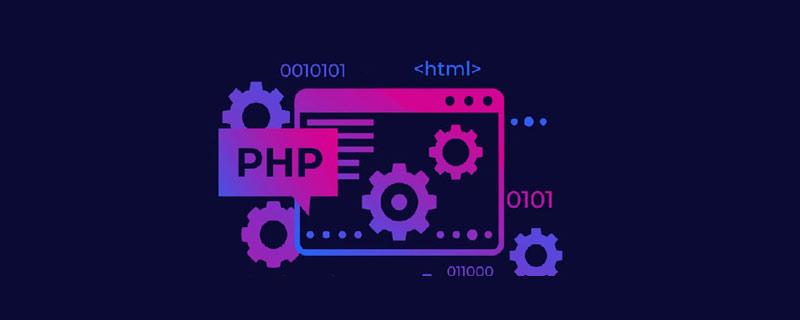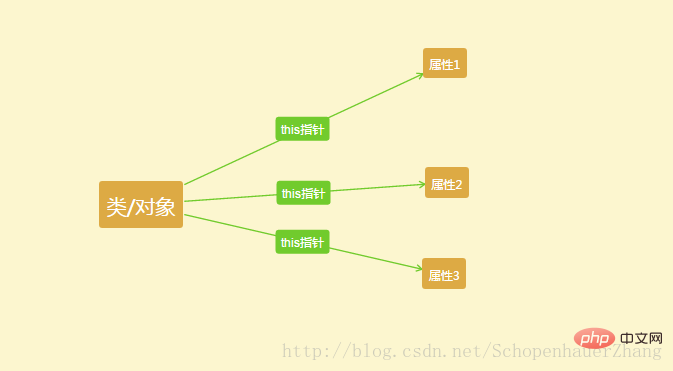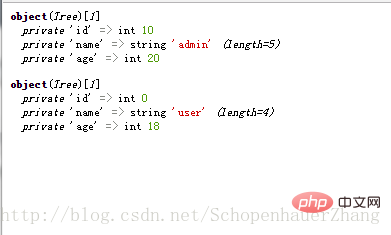Home >Backend Development >PHP Problem >What is php chain writing?
What is php chain writing?
- 藏色散人Original
- 2021-05-24 09:43:063232browse
php chain writing method is "$tree->setAge()->setID()->setName();", where in the php class this pointer points to the class/object itself, it Like a rope connecting the class/object to the attributes and functions of the class.

This pointer has similar functions in different programming languages, but the specific details are different.
But there is a basis for pointing to the object/function/class itself. Based on this basis, chain writing can be implemented. Take php as an example.
In the PHP class, the this pointer ($this) points to the class/object itself. It is like a rope connecting the class/object with the attributes and functions of the class. And you can use it to call the corresponding properties and functions (methods). As shown below: 
<?php
/**
* Created by PhpStorm.
* User: dell
* Date: 2017/3/31
* Time: 21:42
*/
/*
*注释的规范写法:@param [参数类型] 参数名 参数解释
* @return 返回值 [类型] 返回值名 返回值说明
*/
class Tree{
private $id ;
private $name;
private $age;
/*
*
* @param null
* @return null
*
*/
public function _construct()
{
//构造函数
}
/*
*
* @param [array] $arr 参数1
* @return null
*
*/
public function init( $arr = array() )
{
//初始化函数
$arrs = array();
//设置默认参数
$arrs = [
'id'=> 1,
'name'=> 'user',
'age' => 18
];
if( !(is_array($arr)) )
{
//如果传进来的数据不是数组则默认是id
$this->id = intval( $arr );
}
$arrs = array_merge( $arrs , $arr );//合并数组
//给类的属性赋值
$this->id = $arrs['id'];
$this->name = $arrs['name'];
$this->age = $arrs['age'];
}
/*
*
* @param [int] $data 参数1
* @return $this
*
*/
public function setID( $data = 0 )
{
//判断是不是数字
$this->id =is_numeric( $data )? $data : intval($data) ;//判断是否是数字,是赋值,否则转为数字在赋值
return $this;//返回this指针
}
/*
*
* @param [string] $data 参数1
* @return $this
*
*/
public function setName( $data = 'user' )
{
//判断是不是数字
$this->name =is_string( $data )? $data : strval($data) ;//判断是否是字符串,是赋值,否则转为字符串在赋值
return $this;//返回this指针
}
/*
*
* @param [int] data 参数1
* @return $this
*
*/
public function setAge( $data = 18 )
{
//判断是不是数字
$this->age =is_numeric( $data )? $data : intval($data) ;//判断是否是数字,是赋值,否则转为数字在赋值
return $this;//返回this指针
}
};
$tree = new Tree();
$array = array();
$array['id'] = 10;
$array['name'] = 'admin';
$array['age'] = 20;
$tree->init($array);
var_dump($tree);//打印结果
$tree->setAge()->setID()->setName();//链式写法
var_dump($tree);//在打印看链式写法是否有效
?>Output result:

The premise that functions/methods can implement chain writing is that the return value is this pointer (return $this in php, return this in js, and similar in other languages). Only in this way can the this pointer be returned after calling this function. Logically speaking, what is returned at this time is the class itself, and then continue to call the function and return the this pointer, and so on.
Of course, each programming language has its differences. For example, c is ->, php->, and js or jq is...; the calling form is different but the principle is the same.
One point, there is a this pointer, return this pointer, and then you can implement chain writing and can be used cyclically ->fun1(return this)->fun2(return this)->fun3 (return this)…… .
The above is the detailed content of What is php chain writing?. For more information, please follow other related articles on the PHP Chinese website!

